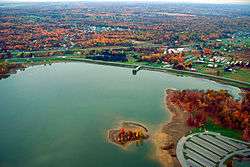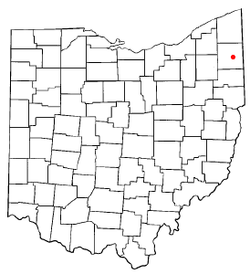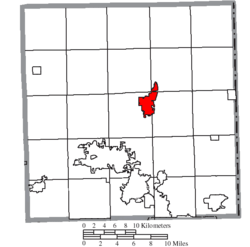Cortland, Ohio
Cortland is a city in Trumbull County, Ohio, United States located on the eastern shore of Mosquito Creek Reservoir 19 miles north of Youngstown. Walnut Run is the creek that runs through town. The population was 7,104 at the 2010 census. It is part of the Youngstown-Warren-Boardman, OH-PA Metropolitan Statistical Area. Cortland became a village in 1874 with the construction of a railroad depot. It became a city in 1980 when its population exceeded 5,000 people.
Cortland, Ohio | |
|---|---|
| City of Cortland | |
 | |
 Location of Cortland in Ohio | |
 Location of Cortland in Trumbull County | |
| Coordinates: 41°19′50″N 80°43′18″W | |
| Country | United States |
| State | Ohio |
| County | Trumbull |
| Government | |
| • Mayor | Deidre Petrosky[1] |
| Area | |
| • Total | 4.33 sq mi (11.22 km2) |
| • Land | 4.33 sq mi (11.22 km2) |
| • Water | 0.00 sq mi (0.00 km2) |
| Elevation | 1,024 ft (312 m) |
| Population | |
| • Total | 7,104 |
| • Estimate (2019)[4] | 6,768 |
| • Density | 1,561.97/sq mi (603.10/km2) |
| Time zone | UTC-5 (EST) |
| • Summer (DST) | UTC-4 (EDT) |
| ZIP code | 44410 |
| Area code(s) | 234/330 |
| FIPS code | 39-18812[5] |
| GNIS feature ID | 1056839[6] |
| Website | http://www.cityofcortland.org |
The area was once known as Baconsburg, after Samuel Bacon, who built a sawmill and several buildings in the area during the early 19th century.
Geography
According to the United States Census Bureau, the city has a total area of 4.25 square miles (11.01 km2), all land.[7] According to the City of Cortland webpage, Cortland is located in the heart of Trumbull County, adjacent to Mosquito Reservoir and State Park. State highways 5 and 46 are both accessible through the city. We are also a short distance from Interstate 80 via State Route 11.[8]
Demographics
| Historical population | |||
|---|---|---|---|
| Census | Pop. | %± | |
| 1880 | 616 | — | |
| 1890 | 697 | 13.1% | |
| 1900 | 620 | −11.0% | |
| 1910 | 612 | −1.3% | |
| 1920 | 750 | 22.5% | |
| 1930 | 940 | 25.3% | |
| 1940 | 1,014 | 7.9% | |
| 1950 | 1,259 | 24.2% | |
| 1960 | 1,957 | 55.4% | |
| 1970 | 2,525 | 29.0% | |
| 1980 | 5,011 | 98.5% | |
| 1990 | 5,666 | 13.1% | |
| 2000 | 6,830 | 20.5% | |
| 2010 | 7,104 | 4.0% | |
| Est. 2019 | 6,768 | [4] | −4.7% |
| Sources:[5][9][10][11][12][13] | |||
2010 census
As of the census[3] of 2010, there were 7,104 people, 3,010 households, and 2,032 families living in the city. The population density was 1,671.5 inhabitants per square mile (645.4/km2). There were 3,211 housing units at an average density of 755.5 per square mile (291.7/km2). The racial makeup of the city was 97.0% White, 1.2% African American, 0.2% Native American, 0.5% Asian, 0.2% from other races, and 0.9% from two or more races. Hispanic or Latino of any race were 0.9% of the population.
There were 3,010 households, of which 29.2% had children under the age of 18 living with them, 54.3% were married couples living together, 9.6% had a female householder with no husband present, 3.7% had a male householder with no wife present, and 32.5% were non-families. 28.6% of all households were made up of individuals, and 14.4% had someone living alone who was 65 years of age or older. The average household size was 2.33 and the average family size was 2.86.
The median age in the city was 44.4 years. 22% of residents were under the age of 18; 6.4% were between the ages of 18 and 24; 22.3% were from 25 to 44; 30.7% were from 45 to 64; and 18.6% were 65 years of age or older. The gender makeup of the city was 47.0% male and 53.0% female.
2000 census
As of 2000, there were 6,830 people, 2,738 households, and 1,968 families living in the city. The population density was 1,524.8 people per square mile (588.6/km2). There were 2,899 housing units at an average density of 647.2 per square mile (249.8/km2). The racial makeup of the city was 97.61% White, 0.94% African American, 0.12% Native American, 0.38% Asian, 0.12% from other races, and 0.83% from two or more races. Hispanic or Latino of any race were 0.75% of the population.
There were 2,738 households, out of which 32.6% had children under the age of 18 living with them, 59.5% were married couples living together, 10.0% had a female householder with no husband present, and 28.1% were non-families. 24.3% of all households were made up of individuals, and 10.6% had someone living alone who was 65 years of age or older. The average household size was 2.48 and the average family size was 2.97.
In the city the population was spread out, with 24.6% under the age of 18, 7.4% from 18 to 24, 26.5% from 25 to 44, 27.9% from 45 to 64, and 13.5% who were 65 years of age or older. The median age was 40 years. For every 100 females, there were 90.0 males. For every 100 females age 18 and over, there were 85.5 males.
The median income for a household in the city was $50,941 and the median income for a family was $62,441. Males had a median income of $50,739 versus $28,320 for females. The per capita income for the city was $22,972. About 4.6% of families and 5.3% of the population were below the poverty line, including 6.3% of those under age 18 and 3.0% of those age 65 or over.
Education
Lakeview Local Schools operates one Pk-8 Building and one high school (Lakeview High School).[14]
Cortland has a public library, a branch of the Warren-Trumbull County Public Library.[15]
References
- "Mayor's Office".
- "2019 U.S. Gazetteer Files". United States Census Bureau. Retrieved July 27, 2020.
- "U.S. Census website". United States Census Bureau. Retrieved 2013-01-06.
- "Population and Housing Unit Estimates". Retrieved May 21, 2020.
- "U.S. Census website". United States Census Bureau. Retrieved 2008-01-31.
- "US Board on Geographic Names". United States Geological Survey. 2007-10-25. Retrieved 2008-01-31.
- "US Gazetteer files 2010". United States Census Bureau. Archived from the original on 2012-07-14. Retrieved 2013-01-06.
- "Archived copy". Archived from the original on 2017-01-19. Retrieved 2017-01-21.CS1 maint: archived copy as title (link)
- "Population of Civil Divisions Less than Counties" (PDF). Statistics of the Population of the United States at the Tenth Census. U.S. Census Bureau. 1880. Retrieved 28 November 2013.
- "Population: Ohio" (PDF). 1910 U.S. Census. U.S. Census Bureau. Retrieved 28 November 2013.
- "Population: Ohio" (PDF). 1930 US Census. U.S. Census Bureau. Retrieved 28 November 2013.
- "Number of Inhabitants: Ohio" (PDF). 18th Census of the United States. U.S. Census Bureau. 1960. Retrieved 24 April 2020.
- "Ohio: Population and Housing Unit Counts" (PDF). U.S. Census Bureau. Retrieved 22 November 2013.
- "Homepage". Lakeview Local Schools. Retrieved 3 March 2018.
- "Locations". Warren-Trumbull County Public Library. Archived from the original on 3 March 2018. Retrieved 3 March 2018.
